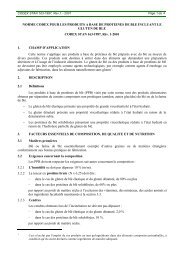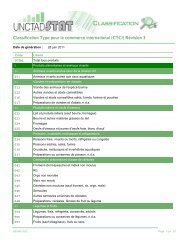issues and constraints related to the development of cashew nuts ...
issues and constraints related to the development of cashew nuts ...
issues and constraints related to the development of cashew nuts ...
You also want an ePaper? Increase the reach of your titles
YUMPU automatically turns print PDFs into web optimized ePapers that Google loves.
16At ano<strong>the</strong>r site, half-siblings <strong>of</strong> twenty five locally selected “mo<strong>the</strong>r trees” were being evaluated,with four seeds from one tree being planted per plot <strong>and</strong> replicated twice.There does not appear <strong>to</strong> have been much new planting material introduced in very recent years.However, in <strong>the</strong> past, <strong>the</strong>re has been quite a lot, e.g. ‘Block NW-7’ <strong>and</strong> o<strong>the</strong>rs at Ochaja substation<strong>and</strong> Brazilian “common” or “jumbo” seed imported <strong>and</strong> planted at Kosoni-Ola Farm (Oro,Kwara State). On Kosoni-Ola Farm, an area <strong>of</strong> 350 ha was planted entirely with Brazilian“common” seed imported from Brazil. Planting started in 1986 <strong>and</strong> was finished by 1988 <strong>and</strong><strong>the</strong>n gapping (filling in <strong>of</strong> spaces) continued. Nut size was variable, but a high percentage <strong>of</strong>trees were giving a very good nut size. It is from this farm that Ghana imports <strong>the</strong> Nigerian“jumbo” <strong>nuts</strong>. Yields were low, last year 250 ha produced only 50 <strong>to</strong>ns, equal <strong>to</strong> only 200kg/ha.However this type <strong>of</strong> tree needs <strong>to</strong> be evaluated fully, e.g. for yield potential per ha, kernelweight, percentage kernel out-turn, etc. before recommending it <strong>to</strong> <strong>the</strong> farmer.Improved seed sold by CRIN comes from selected individual trees, but because <strong>of</strong> out-crossing, itis likely <strong>to</strong> be very variable. A polyclonal seed garden would improve seed production. Hereclones <strong>of</strong> a number <strong>of</strong> <strong>the</strong> best trees (perhaps 20) are grown <strong>to</strong>ge<strong>the</strong>r in a certain arrangement <strong>and</strong>allowed <strong>to</strong> cross pollinate. The resulting seed would be a mixture <strong>of</strong> <strong>the</strong> characters <strong>of</strong> <strong>the</strong> selectedclones <strong>and</strong> resulting trees should be better than <strong>the</strong> existing farmers’ treesOnly air-layering (marcotts) had been practised on a limited scale; this technique is rarely used<strong>the</strong>se days, because it is time consuming <strong>and</strong> has a low success rate; tip or bud grafting arenormally used in East Africa, India <strong>and</strong> Brazil.Nigeria has a long his<strong>to</strong>ry <strong>of</strong> <strong>cashew</strong> breeding research, as demonstrated by replicated germplasmtrials planted in 1977 <strong>and</strong> a number <strong>of</strong> papers published in regional journals.Conclusions on breedingThere is a tremendous amount <strong>of</strong> enthusiasm for <strong>cashew</strong> cultivation amongst both farmers <strong>and</strong> <strong>the</strong>authorities in all <strong>the</strong> five countries, <strong>and</strong> <strong>the</strong> farmers are exp<strong>and</strong>ing <strong>the</strong>ir <strong>cashew</strong>, <strong>of</strong>ten with littleor no support. Only Nigeria has seed for sale that has been evaluated <strong>to</strong> a certain degree <strong>and</strong> even<strong>the</strong>re, <strong>the</strong> CRIN seed could be substantially improved.The universal complaint in all <strong>the</strong> five countries was <strong>the</strong> lack <strong>of</strong> good planting material. Muchneeds <strong>to</strong> be done with regard <strong>to</strong> selection, introducing new material, establishing germplasm trialsfor <strong>the</strong> short, medium <strong>and</strong> long term, breeding <strong>and</strong> finally distribution <strong>of</strong> planting material <strong>to</strong>farmers. Because <strong>of</strong> <strong>the</strong> long time frame for evaluating <strong>cashew</strong> material, <strong>the</strong> need <strong>to</strong> multiplygood material for distribution <strong>and</strong> <strong>the</strong> importance <strong>of</strong> providing farmers with <strong>the</strong> right material,funding for a future regional breeding programme should be given <strong>the</strong> highest priority.A <strong>related</strong> area that needs immediate attention is <strong>the</strong> introduction <strong>of</strong> tip or bud grafting techniques<strong>to</strong> produce clones (genetic replicas <strong>of</strong> <strong>the</strong> original mo<strong>the</strong>r tree). Without this technique, <strong>the</strong>breeder’s trials are severely constrained, since <strong>the</strong>y have <strong>to</strong> use half-sibling seeds all <strong>the</strong> time,which introduces more variability in<strong>to</strong> <strong>the</strong> trials. With <strong>cashew</strong> being such a variable cropanyway, this is undesirable.Research capacityWith <strong>the</strong> exception <strong>of</strong> Nigeria, generally speaking very little research has been undertaken on any<strong>cashew</strong> <strong>related</strong> <strong>to</strong>pics in <strong>the</strong> five countries. This lack <strong>of</strong> research is not really surprising, as it


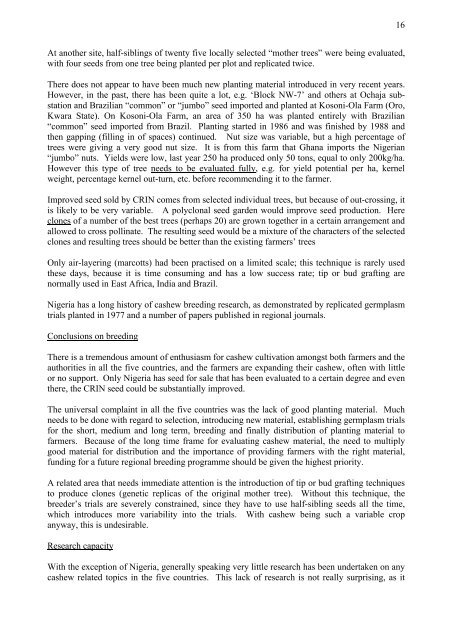
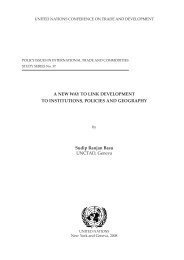


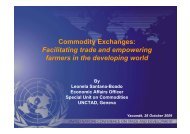
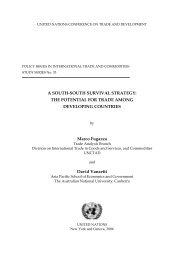
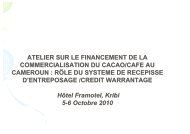
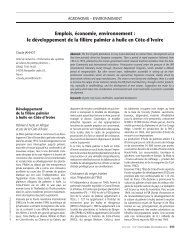
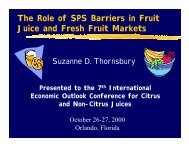

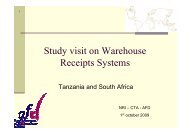
![Warehouse Receipt Systems: Legal Issues [PDF]](https://img.yumpu.com/43979338/1/190x134/warehouse-receipt-systems-legal-issues-pdf.jpg?quality=85)
